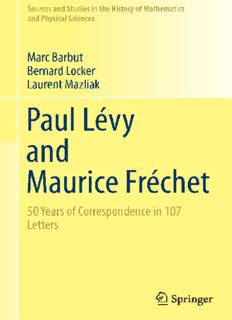
Paul Lévy and Maurice Fréchet: 50 Years of Correspondence in 107 Letters PDF
Preview Paul Lévy and Maurice Fréchet: 50 Years of Correspondence in 107 Letters
Paul Lévy and Maurice Fréchet Sources and Studies in the History of Mathematics and Physical Sciences Forfurthervolumes: www.springer.com/series/4142 Marc Barbut (cid:2) Bernard Locker (cid:2) Laurent Mazliak Paul Lévy and Maurice Fréchet 50 Years of Correspondence in 107 Letters Translation of the introductory sections and most of the notes by Peter Kleban, Professor Emeritus LASST & Department of Physics and Astronomy University of Maine MarcBarbut(deceased) LaurentMazliak ProfessorBarbutwrotethiswhileatEHESS LaboratoiredeProbabilitésetModèles Paris,France Aléatoires UniversitéPierreetMarieCurie BernardLocker Paris,France UFRdeMathématiques UniversitéRenéDescartes Paris,France ISSN2196-8810 ISSN2196-8829(electronic) SourcesandStudiesintheHistoryofMathematicsandPhysicalSciences ISBN978-1-4471-5618-5 ISBN978-1-4471-5619-2(eBook) DOI10.1007/978-1-4471-5619-2 SpringerLondonHeidelbergNewYorkDordrecht LibraryofCongressControlNumber:2013955594 MathematicsSubjectClassification: 01A60,60-03,60J65,31-03 BasedonatranslationfromtheFrenchlanguageedition: ‘PaulLévy-MauriceFréchet:50ansdecorrespondancemathématique’ editedbyMarcBarbut,BernardLockerandLaurentMazliak Copyright©Hermann,Paris,2004 AllRightsReserved ©Springer-VerlagLondon2014 Thisworkissubjecttocopyright.AllrightsarereservedbythePublisher,whetherthewholeorpartof thematerialisconcerned,specificallytherightsoftranslation,reprinting,reuseofillustrations,recitation, broadcasting,reproductiononmicrofilmsorinanyotherphysicalway,andtransmissionorinformation storageandretrieval,electronicadaptation,computersoftware,orbysimilarordissimilarmethodology nowknownorhereafterdeveloped.Exemptedfromthislegalreservationarebriefexcerptsinconnection with reviews or scholarly analysis or material supplied specifically for the purpose of being entered and executed on a computer system, for exclusive use by the purchaser of the work. Duplication of this publication or parts thereof is permitted only under the provisions of the Copyright Law of the Publisher’slocation,initscurrentversion,andpermissionforusemustalwaysbeobtainedfromSpringer. PermissionsforusemaybeobtainedthroughRightsLinkattheCopyrightClearanceCenter.Violations areliabletoprosecutionundertherespectiveCopyrightLaw. Theuseofgeneraldescriptivenames,registerednames,trademarks,servicemarks,etc.inthispublication doesnotimply,evenintheabsenceofaspecificstatement,thatsuchnamesareexemptfromtherelevant protectivelawsandregulationsandthereforefreeforgeneraluse. Whiletheadviceandinformationinthisbookarebelievedtobetrueandaccurateatthedateofpub- lication,neithertheauthorsnortheeditorsnorthepublishercanacceptanylegalresponsibilityforany errorsoromissionsthatmaybemade.Thepublishermakesnowarranty,expressorimplied,withrespect tothematerialcontainedherein. Printedonacid-freepaper SpringerispartofSpringerScience+BusinessMedia(www.springer.com) Tenyearsafterthepublicationofthefirstedition inFrench,andthoughoneofusisnowamongus onlyinspirit,itisstillthreegenerationswhoare gladtodedicatethisbooktoourfriend, colleagueandmaster BernardBru forhisseventiethbirthday,whoseenergyand immenseculturehadalwaysbeenforusa pricelesssupportandwhoseworkhas contributedsoessentiallytothedisseminationof thehistoryofmathematics. MarcBarbut†,BernardLockerand LaurentMazliak Inmemoriam SincetheFrenchversionofthisbookwas published,ourcolleagueandfriendMarcBarbut passedawayinDecember2011.Hisenthusiasm, hisendlessculture,hispassionfortheworkof thetwoprotagonists(hehadmetbothofthemin hisyouth),wereessentialingredientsforthe completionofthiswork.Wearegladtoseizethis opportunitytorecallhisgoodmemoryandalso toofferabookheappreciatedalottoalarger audience. BernardLockerandLaurentMazliak Paris,September2013 Preface by Kai Lai Chung PaulLévy’sbookswerenoteasyofaccessinKunming,China,duringthewaryears attheSouthwestAssociatedUniversities,owingtoJapanesebombingofthecity.1 IarrivedatPrincetoninDecember1945butitwaslaterthatIsawCaptainGilHunt poringoverl’Addition.2HetoldmethatvonNeumannsaid:readingLévy,onesoon realizesthattheauthorthinksmathematicsinadifferentwayfromnousautres. IfirstsawLévyatBerkeley,summerof1950,whenhewasgivingacoursewhich I attended. One day I went to his office and asked him about a result for Markov chains. At once he indicated a counter-example. It must be then or soon after that I mentioned the conjecture regarding the positivity of a transition function p (t): ij eitheritvanishesforallt oritneverdoes.Inhisepoch-makingpaper3hebeganwith thisoccasion.Hecallsastatei“stable”if−p(cid:2) (0)<∞,“instantaneous”otherwise. ii Abasicpropertyofastablestatehestates,isthatthetime-setinwhichastablestate occurs is (almost surely) a sequence of disjoint intervals of which the cardinality is finite up to any finite time. This must be obvious to him but missed by Mon- sieur Doob who published two important papers on denumerable Markov chains. The proof actually needs a little “measure-theoretic”fiddling which I presented at Feller’sseminarlater.TheproofinLévy’spaperofthetruthoftheconjectureabove isvalidifallstatesarestable,asconfirmedinthedoctoratethesisofR.V.Chacon (atSyracuseUniversity).ItwastherecentlydeceasedDonaldG.Austinwhogave a beautiful complete proof of the conjecture by so-called “path-analysis.”4 It was likeLévythatheannouncedhisoversightinaComptesRendusnotesoonafterhe recognizedit.HewrotemetosaythathelikedAustin’sproof. Turningtheclockbackto1947-9,whenIwasatCornell,thediscoveryofLévy’s long paper,5 not available during the war, caused a sensation with Feller and Kac. 1SeeSem.Stoch.Process.(1988). 2ThebookLévy(1937). 3Ann.Sci.Ec.Norm.Super.68:327–381(1951). 4SeeChung:Markovchains,Springer(1960&1967). 5Compos.Math.7:283–339(1939). vii viii PrefacebyKaiLaiChung Among the numerous new results, the “arcsin” law together with its complement “uniformlaw”forBrownianMovementwasanunheraldedevent.FellerandIwrote a note transferring both results to the classical setting of coin-tossing, heads or tails with fifty-fifty chance. The resulting statistical interpretation is so contrary to common-sense “intuition” that had Chevalier de Méré been at the gaming ta- ble he would certainly have rushed to consult Fermat or Pascal. Indeed the news wasevenreportedinapopularsciencebulletin,ofwhichFellerkiddedmeasbeing theinformer—Iwasnot.Lévy’sarticlecontainssuchawealthofideasandmethods whichremaintobeexploredtothisday. Probably the best known of Lévy’s multifarious achievements is the family of “infinitely divisible laws” with numerous ramifications and “applications” includ- ing the “normal” and “stable” laws (another kind of stability, both named by the discoverer). The general formula for their Fourier transform (ch.f.) is sometimes citedas“Khinchine-Lévy,”insillyEnglishalphabeticalorder.6InaletterLévysaid K.completeditintheunsymmetricCauchycase(only).InthebookbyGnedenko andKolmogorov,itwasproperlynamed.WhatisnotwellknownisthatinLévy’s hands, it is just the analytic portion of his profound study of the paths of “Lévy process(es),” formerly called “additive,” “differential” etc. I must refer the really interested reader to my Review of Doob’s book Stochastic Processes7 for further comments.LetmeaddthatifLévy’sotherrenownedpublicationsarenotevenmen- tionedhere,itisbecauseofmylackofpersonalknowledgeofthem,aswellasthe lackofSPACEandTIME. ThecelebratedTheoremontheconvolutionoftwoNormallawswasconjectured byLévywhoactuallyassumeditstruthinhisearlyworkontheinfinitelydivisible family.ItwasHaraldCramérwhoprovedLévy’sdaringconjecture,usingproperties ofentirefunctionincomplexanalysis.HisCambridgetract,lenttomebyProf.Pao LuHsuintatteredcondition,wasapreciousguide.AttheBicentennialconvocation of Princeton University in 1946, Cramér was a visiting professor who gave two successivecoursesonmodernprobability.Iwasassignedtobehisassistant,andhe approvedmydissertation(1947).Prof.PaoLuHsu,theninUSA,wasalsoaninvited delegate, but he did not come (see my Preface to his Collected Papers, Springer- Verlag, 1982 with a photo of Hsu, Cramér and Bartlett in Chapel Hill). It was on thebicentennialoccasionthatIfirstmetFeller,Doob,AbrahamWaldamongmany othermathematiciansknowntomebynamebefore. OnMay19,1964Lévywrotemealetterpartofwhichannouncinghiselection tol’Académie(inmuchdetail),theotherpartaboutMrsDoeblin’spassing.Asre- sponseIaskedhimsoonaftertopresentaNotetotheComptesRendus(myfinalone there).Itisabouta“pregnantintegralequation”obtainedbyconsideringalastexit 6Bytheway,itwouldbeinterestingtoshowthefollowingresultwithoutusingFouriertransform: for any stable non-normal law with distribution function L, we have 1−L(x)∼Cx−α, for a constant 0<α<2 as x→+∞. The problem has made some progress. The most interesting resultisduetoLettaandPratelliwhoobtainedP(X>x)≤cx−αforanysymmetricstablelaw. 7Bull.Am.Math.Soc.(March1954).NumerousotherreferencestoLévyarementioned,including hisprecursorMartingale. PrefacebyKaiLaiChung ix timefromaboundaryforMarkovchain,whichIhadspokenofinBudapest,Prague andelsewere.AnalmosteverywheresolutioniseasybutIwasunabletoshowitev- erywhere.HerewroteitaftertelephoningJacquesNeveufor“information”andsplit it in two Notes which appeared in May, 1965. The open problem was first solved by Lennart Carleson with his fine analysis, of which I wrote a reproduction in a ChinesejournalpublishedinDalian.Lévyusedtowritetomewhilesummeringin Menton,theborderfromVentimiglia,wheremywifeandIsojournedonce. DuringourstayinStrasbourgin1967,whereourfive-yearoldsonwenttoFrench school and learned to speak very well, the Lévys kindly invited us to dinner in theirtop-floorapartmentonAve.ThéophileGautier,justabovetheresidenceofthe novelist Mauriac, we found out later. The guests included the Chevalleys and the Schwartzes(IfirstmetLaurentatProf.Chevalley’sofficeinPrincetonUniversity). Monsieur Lévy offered me a little cup of Port-Salut, warning me of its parfum. Thoseweremarvellousdays. After the Lévy Memorial Colloque at Palaiseau in 1987, we were chez eux at theSchwartzes,andLaurenttoldsomestoriesofhisbeau-père’speculiarmemory of what he had or had not demonstrated the day before. Mme Schwartz was most kindingivingmeaphotoofherfatherandoneofEmileBorel,bothreproducedin myElementaryProbabilitybookwithsixotherluminaries.Lévyhadpassedaway in1971.Thathappenedtobethefirstpassagetimeformyreturntomyhomeland andtoseemymotherinHangchow,MarcoPolo’sQinsai.“TIMEMUSTHAVEA STOP.” In1976IwasabletodedicateapapertoLévy’smemory.8Iwasgivingacourse on Brownian Motion (sic) with a few faculty auditors (incl. S.T. Yau now in Har- vard). A basic theorem in Lévy’s étude profonde, proved by him using a “vertical window,” baffled me as too hard to do in class, but I was happy when I found a “horizontalwindow”toreplaceit,byuseofalast-exittime(Theorem1ofthemen- tionedpaper).ThelingowasduetomyfriendanauditorfromOperationResearch occurred. The Brownian excursions being the groundwork for Lévy’s fantastic invention of “local time,” I wrote with A.A. Balkema another paper entitled “Lévy’s WAY tohislocaltime”inourSeminaronStochasticProcesses,1990(Birkhäuser).The capitalizedWAYistakenfromLaotzeandChuangtze,pronouncedlike“TAO.” MyacquaintancewithMauriceFréchetisbrief:Ifirstsawhimatagroupwalk in a Japanese garden in Tokyo, in 1960. He looked very handsome and was most cordial. Unfortunately somehow on the crowd we did not have a chance to talk. However our first contact occurred at the time when Paris fell to the Nazis. Sud- denlyIreceivedawholebunchofreprintssentbyhim(IwishIhadkeptthelarge envelope,buthisreprintsarehere.)ThismustbehiskindresponsetoaNoteonan inequalitybyE.J.GumbelIsenttoBorelforpossiblepresentationtotheAcadémie. Fréchet also sent a postcard when my professor Pao Lu Hsu and I sent a Note on recurrence(1946).LaterIgotagalleycopyofFréchet’sfirstvolumeonprobabili- tiesofafinitenumberofeventsintheActualitésseries.Ihadpublishedanumberof 8Ark.Mat.14(1976). x PrefacebyKaiLaiChung papers on the same subject in the Annals of Mathematical Statistics (1941–1945). Owingtothelackofcommunicationduringthewar,Fréchet’stwovolumesandmy papersdidnotseemtorencontre.GumbelinvitedmetohishomeinBronx,New- YorkCity,soonaftermyarrivalinUSAneartheendofNovember(1945).Wemet againinTokyo,andwehadalastsuppertogetherattheinnwhenallotherguests had left. Indeed, he was the first mathematician/statistician I met in America. He wasmostkindtovisitmeinPrincetonwhereIwasagraduatestudent.Muchlater he shared an office with a doctorate student of mine at Columbia University. This provesthatthereisTIMErecurrenceinthismundaneworld.Ialmostforgottosay abovethatFréchet’sGénéralitésintheBorelcollectionwasoneofmyfirstintroduc- tion to probability after Borel’s treatise. Prof. Hsu had a copy of Fréchet’s second volume on Markoff chains which I read. Only much later when I taught a course on general topology I learned Fréchet’s pioneer work on that, and other kinds of mathematics(incl.economics,IlearnedrecentlyfromProfsBruandBarbut).This worldisconnectedinSPACEtoo. Athome,Stanford,California September1st,2003
Description: